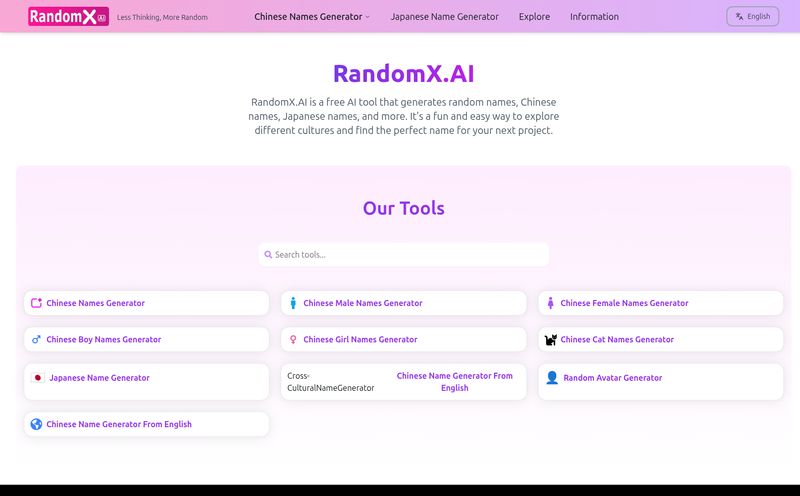I’ve been in the SEO and digital trends game for a long time. Long enough to remember when a customizable avatar meant choosing between three different pixelated hairstyles. So when a tool comes along that claims to create lifelike digital humans from a single photo, video, or even just a set of measurements, my ears perk up. The platform in question is Meshcapade Me.
Naturally, the first thing I did was try to check out their website. And what did I find? A big ol' 403 Error from CloudFront. Now, my inner cynic immediately thinks, 'well, that's not a great start.' But the optimist in me, the one who's seen a dozen high-demand AI tools get hugged to death by traffic on launch day, wonders... are they just that popular? Or maybe they're in the middle of a massive update. Either way, it adds a bit of mystery, doesn't it?
Despite the digital barricade, I've managed to piece together what Meshcapade Me is all about. And honestly, it sounds like the kind of tecnhology we've been promised for years.
So, What's the Big Deal with Meshcapade Me?
At its core, Meshcapade Me is an avatar creation platform. But that's like saying a Ferrari is just a car. It uses a powerful cocktail of computer vision and machine learning to generate stunningly realistic 3D avatars. The promise is “no-friction” creation, which is a bold claim in the often clunky world of 3D modeling.
The really interesting part is the input versatility. We’re not just talking about uploading a perfectly lit headshot. They claim you can use:
- Simple images (like a selfie)
- Videos
- Body measurements
- Professional 3D/4D scans
- Even text descriptions!
This flexibility is what separates it from the pack. It’s aiming to be a universal translator for human bodies, creating a consistent, high-quality digital version of you that can exist anywhere.
The Magic Under the Hood: SMPL Technology
Okay, let’s get a little geeky. The secret sauce behind Meshcapade Me is its patented SMPL Body Model technology. SMPL stands for Skinned Multi-Person Linear Model. I had to dust off some old research bookmarks for this one, but it's a fascinating concept originally developed at the Max Planck Institute for Intelligent Systems. Think of it as a highly advanced digital skeleton and skin that understands human anatomy.
Instead of just stretching a texture over a generic model, SMPL can realistically represent a vast spectrum of human body shapes and poses. This is why their avatars don't have that uncanny, 'plastic doll' look. This unified format is the holy grail for interoperability. An avatar created for a virtual try-on at a fashion retailer could, in theory, be ported directly into a video game or a metaverse conference call without looking out of place. That’s a huge deal.
From Photo to Photorealistic Human
The process itself sounds almost too simple. You feed the API your data, and it spits out a lifelike digital human. It’s the sheer variety of what you can feed it that is so impressive.

Visit Meshcapade Me
Creating Avatars from Images and Videos
This is the most accessible method. The idea of taking a quick video with my phone and getting a fully rigged, realistic 3D model of myself is incredibly appealing. This lowers the barrier to entry for casual users, content creators, and small businesses who dont have access to expensive scanning equipment.
The Precision of Measurements and Scans
For professional applications, accuracy is everything. This is where using measurements or full-body scans comes in. For e-commerce, this is a game-changer. Imagine an online clothing store where you can upload your measurements and see an avatar with your exact body shape try on a jacket. The potential to reduce returns and improve customer satisfaction is massive. It's like having a digital tailor on call 24/7.
Wait, You Can Make Avatars from Words?
This one really caught my eye. The info says it can convert words into digital humans. This feels like the next frontier, blending large language models with computer vision. I imagine it works something like, "Create a 6-foot-tall male, athletic build, with broad shoulders and brown hair." If it's as good as it sounds, this could be an incredible tool for concept artists, game developers, and storytellers who need to visualize characters quickly.
The Good, The Not-So-Good, and The API
No tool is perfect, right? From what I can gather, Meshcapade Me has some incredible strengths but also a few things to keep in mind.
The biggest advantage is clearly the lifelike quality and the versatile input options. It's taking a complex process and making it accessible. The use of a scientifically-backed model like SMPL gives it a level of credibility that many competitors lack. On the flip side, the main access point seems to be through an API. For a marketer like me, that's fine, I can talk to a developer. But for a solo creator or a small business owner without technical chops, 'API-first' can be an intimidating phrase. It suggests this is more of a B2B solution than a simple consumer app, at least for now.
Another point mentioned is that loading times can vary. That's not surprising for a cloud-based service doing heavy-duty 3D rendering. It's just a reality of the current infrastructure, but something to be aware of if you're building a real-time application on top of it.
So, Who Is This Actually For?
The applications for this kind of technology are broad. I can see it being a huge hit in a few key areas:
- E-commerce & Fashion: The virtual try-on space is the most obvious and potentially most lucrative.
- Gaming & Metaverse: Creating a game character that actually looks like you? Yes, please. This is the next evolution of personalization.
- Health & Fitness: Imagine a fitness app that doesn't just track your weight, but creates a 3D model to show your body composition changes over time. That's powerful motivation.
- Virtual and Augmented Reality: For remote work and social VR, having a realistic avatar that can mimic your expressions and movements is crucial for feeling present.
What's the Price Tag?
And now for the million-dollar question. Or, hopefully, the much-less-than-a-million-dollar question. As I mentioned, their site was down when I tried to check, so I couldn't get a look at a pricing page. There's no public information available at the moment.
Given its API-centric nature, I would speculate that they operate on a usage-based model. This could mean paying per avatar created, or tiered monthly subscriptions that offer a certain number of API calls. It's almost certainly geared towards businesses that will be integrating the technology into their own platforms.
Frequently Asked Questions about Meshcapade Me
- What is Meshcapade Me?
- Meshcapade Me is an advanced AI-powered platform that creates highly realistic 3D digital avatars of people from various inputs like photos, videos, body measurements, or even text descriptions.
- What is SMPL technology?
- SMPL (Skinned Multi-Person Linear Model) is a realistic 3D body model that can accurately represent a wide variety of human body shapes and poses. It's the core technology that allows Meshcapade Me to create such lifelike avatars.
- Can I use Meshcapade Me without coding skills?
- The primary interface for Meshcapade Me appears to be its API (Application Programming Interface). This suggests that some technical knowledge or a developer would be needed to integrate and use the service effectively.
- What kinds of files can I use to create an avatar?
- You can use a wide range of inputs, including standard images (like a phone selfie), videos, a list of body measurements, 3D body scans, and potentially even text prompts.
- Is Meshcapade Me free?
- Pricing information is not publicly available at this time. Given its focus on an API for businesses, it likely operates on a paid, usage-based subscription model rather than being a free consumer tool.
- How accurate are the avatars?
- Thanks to the underlying SMPL technology, the avatars are designed to be highly accurate representations of body shape and form, especially when created from precise inputs like measurements or 3D scans.
Final Thoughts
Despite the website being down, I'm genuinely excited about what Meshcapade Me represents. It's not just another avatar creator. It’s a platform built on serious science that aims to solve a fundamental problem: creating a unified, realistic, and portable digital identity. The bridge between our physical and digital selves is being built, and technologies like this are the girders and bolts holding it all together.
I’ll definitely be keeping an eye on them and will try to get a proper demo as soon as their digital doors are open again. The future of online interaction is personal, and it looks like it’s going to be photorealistic.
References and Sources
- SMPL: A Skinned Multi-Person Linear Model - Max Planck Institute for Intelligent Systems



